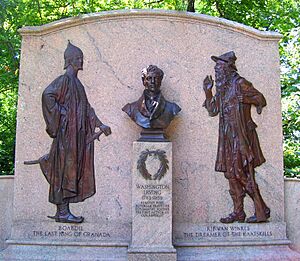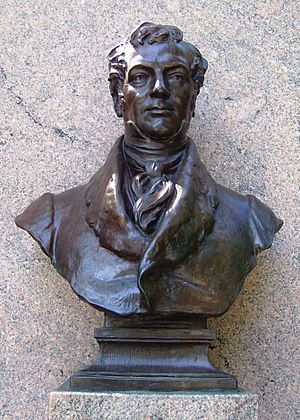Washington Irving Memorial facts for kids
Quick facts for kids |
|
|
Washington Irving Memorial
|
|

(2008)
|
|
| Location | Irvington, New York |
|---|---|
| Nearest city | White Plains |
| Built | 1927 |
| Architect | Charles A. Platt Sculpture: Daniel Chester French |
| Architectural style | Classical Revival |
| NRHP reference No. | 00001062 |
| Added to NRHP | 2000 |
The Washington Irving Memorial is a special monument in Irvington, New York. It honors the famous American writer Washington Irving. You can find it where Broadway (US 9) meets West Sunnyside Lane. The memorial features a sculpture of Irving's head, called a bust. It also has statues of two of his most famous characters.
The well-known sculptor Daniel Chester French created these figures. The whole area, a small stone plaza, was designed by Charles A. Platt. The memorial is very close to Irving's old home, Sunnyside.
A local woman named Jennie Prince Black first thought of building this memorial in 1909. At that time, Irving's home was still private. His fans had no easy way to show their respect. Jennie's dream took almost 20 years to come true. Building the memorial was quite hard. There were many money problems and changes in where it would be placed. It was finally finished and opened in 1927. This was a year later than planned.
Later, Irving's Sunnyside home opened to the public. Many fans now visit there instead. But the memorial was carefully fixed up in the late 1900s. It still looks just as it was first designed. In 2000, it was added to the National Register of Historic Places. This means it's a very important historical site.
Contents
What Does the Memorial Look Like?
The memorial is on a small, three-sided piece of land. This spot is at the northern edge of Irvington. A small stream called Sunnyside Creek flows nearby. It goes under the memorial through a culvert. This makes the land behind the memorial look like a sloped, wooded area.
The memorial has three main parts. There's a tall central stone panel. It stands about 10 feet (3 meters) high and 8 feet (2.4 meters) wide. On either side of this panel are bronze statues. These show two characters from Irving's stories: Rip Van Winkle and King Boabdil. In the middle, on a 6-foot (1.8-meter) pedestal, is the bust of Washington Irving himself.
Curved stone walls extend from the central panel. These walls are about 4 feet (1.2 meters) high and 12 feet (3.7 meters) long. Beyond these walls, there's more fencing made of wrought iron. This fencing is about 10 feet (3 meters) long on each side. All the stone used is pink Vermont granite. It has dark lines running through it. A special inscription is carved into the center panel. It tells about Irving's different jobs. It also names the two characters shown with him.
In front of the main panel, there are some square stone supports. These were meant for benches that were never built. Two benches were added later on the sides. The ground around the memorial used to be made of flagstone. Now, most of it has been replaced with concrete. There were also plans for a gate and path to the stream. These were never built either.
Building the Memorial
Building the Washington Irving Memorial was quite a challenge. There were many money problems and delays. Finding the right spot for it was also difficult. The location wasn't decided until just a year before it was finished. The cost of the project kept growing. Even with lots of fundraising, the sculptor, Daniel Chester French, was never fully paid. Some issues even continued after the memorial was officially opened.
The Idea for the Memorial
During his life, Washington Irving was seen as America's first great writer. He often welcomed visitors and fans to his home, Sunnyside. After he passed away, his family closed the house. People who wanted to honor him could only visit his grave. This grave is at Sleepy Hollow Cemetery. It's near the Old Dutch Church of Sleepy Hollow. They could also visit his church pew at Christ Episcopal Church. Both of these places are about 2 miles (3.2 kilometers) away in Tarrytown.
In 1909, Irvington held a ceremony. It marked 50 years since Irving's death. A resident named Jennie Prince Black realized the village needed a lasting memorial. She was a composer and the wife of a printing business owner. She felt a strong inner voice telling her to make this happen. She kept trying for years without success.
Then, in 1924, another Irvington resident, Cyrus West Field, helped her. He connected her with the famous sculptor Daniel Chester French. French was one of America's best artists. His involvement made Jennie's dream possible. He was asked to design the memorial that summer. A new group, the Washington Irving Memorial Association, started looking for land and raising money.
Finding the Right Spot
French's design came together quickly. But buying the land was the hard part. Jennie Black wanted the memorial to be on Broadway. She wanted it to be easily seen by traffic on the busy Albany Post Road. She first hoped to put it at the spot where it is now. But the land was difficult to build on. Also, the Irving family didn't want to sell. They worried a memorial would bring too many visitors.
Next, she looked at placing it near the churches. French was concerned it would be too close to the street. But Jennie was making progress. Then she learned that someone from one of the churches didn't want a memorial on church land. They then thought about a property facing Irvington's Main Street. But the owners wouldn't agree.
Finally, the Irving family changed their minds. They saw how hard Jennie was trying. A neighbor, Henry Graves, donated the triangular piece of land. The memorial group then started asking for donations.
Meanwhile, French decided to show Irving as a young man, around 35 years old. This was before Irving lived in the area. French gathered many drawings of the author. He wanted to make sure his sculpture looked as real as possible. He also asked Frank Jefferson for photos. Frank was the son of Joseph Jefferson, a famous actor. Joseph Jefferson was known for playing Rip Van Winkle on stage.
French chose King Boabdil as the other character. He wanted to show how many different kinds of stories Irving wrote. This choice caused some debate. When French sent a plaster model of his work, some people disagreed. George Haven Putnam, a publisher and Irving's biographer, complained. He thought French should have chosen another local character. He suggested someone like Peter Stuyvesant. Putnam also said Boabdil wasn't a major character in Irving's book The Alhambra.
Jennie Black spoke to French about this. But the sculptor reminded her that he was the artist. He said it was his right to decide how to honor Irving in bronze. He even asked his friend Bashford Dean for advice. Dean was an expert on old weapons and armor. He helped French decide what a Moorish king might have worn. Even though Dean didn't think the final choice was perfectly accurate, he agreed it was up to the artist.
Money Troubles
By the spring of 1925, the group had raised $8,000. But the total cost of the memorial was now expected to be $30,000. Half of this amount was French's payment. In July, French told Jennie that the Irving bust was almost done. He said all the work would be ready for the memorial to open in 1926.
Jennie kept raising money. At one point, she got a $5,000 donation from John D. Rockefeller. This was a matching gift. It meant that $25,000 more had to be raised to get Rockefeller's money. Soon after, it was reported that $16,000 had been collected. Other wealthy local people, like Adolph Ochs and Chauncey Depew, also gave money. A scroll with the names of 400 donors was put in a locked box. This box was buried at the monument site.
French showed Jennie a model of his final work in January 1926. She told him, "You have outdone us all a thousandfold." The costs for the memorial kept going up as it became more detailed. French even helped with fundraising. He displayed his plaster model of the Irving bust in his New York studio. This helped bring attention to the project. It was also shown in art exhibitions. The bust was sent to the Gorham Company in Providence in April. There, it was cast in bronze.
Back in Irvington, Jennie and the memorial group were worried about the rising costs. The project was now reaching $50,000. They again contacted the churches in Tarrytown. The land there was flatter. French and Platt both made new plans for those sites. But legal problems stopped the move in June. French told Jennie it would be impossible to finish the memorial by the fall. He suggested waiting until spring 1927. This would also give more time to raise money.
In August, the statues were finished. They were put into storage. Jennie organized two fundraising events in the fall. One was a big pantomime show based on Irving's works. Many local people acted in it at Sunnyside. But she was very disappointed when they only raised $1,000. This was far less than needed. French decided to help again. He made a smaller, 18-inch (46-centimeter) version of his Rip Van Winkle statue. The group could sell copies of this for $500 each. Because of the money problems, the memorial was made simpler. The landscaping and front benches were canceled. The fencing was also made less fancy.
Building and Opening the Memorial
In late fall, Ernest Behrens was paid $5,000 for site work. He cleared a telephone booth and a telephone pole from the spot. He also poured concrete. In the spring, Piccirilli Brothers, a stonecarving company from New York, was paid $14,360. They installed the memorial. On June 24, they reported some problems. The foundation work was faulty. They said these issues should have been fixed before construction. But the memorial was ready, except for the bronze letters. They didn't fit into the grooves cut in the stone.
Three days later, on June 26, 1927, the memorial finally opened. This was despite the problems that weren't fixed yet. Irving's great-great-nephew pulled away the flag covering it. A local schoolchildren's choir sang. Trumpeters also performed. French's artwork was very well liked. One local newspaper writer called it "chaste, dignified and altogether lovely." They noted how it made people look from the characters to the author.
Later Years
The Gorham Company said they were not responsible for the lettering problem. They claimed they had only followed French's plans. New letters were made and put in place in October. French was still owed $5,000. Two years later, the last record in his account book showed he had been paid $14,500. This was $500 less than his original fee.
After the memorial was finished, no more work was done on it for a while. The Rockefeller family bought Sunnyside from the Irving family in 1945. They fixed it up and opened it to the public in 1947. It became a historic house museum. This meant the original reason for the memorial, giving fans a place to visit, was no longer as important.
In 1985, a cleaning project made the stonework and bronze look new again. In the late 1990s, the original flagstone floor was replaced with concrete. This was because the memorial and its benches were being used as a waiting area for local buses. New York's Department of Transportation also put up a traffic light at the corner. This blocked the view of the memorial for southbound traffic. It was similar to the old telephone pole that the designers had hoped was gone forever.
Images for kids



